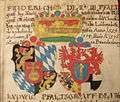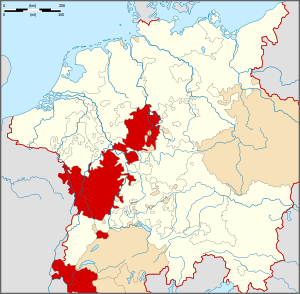Electoral Palatinate
The County Palatine of the Rhine (German: Pfalzgrafschaft bei Rhein), later the Electorate of the Palatinate (German: Kurfürstentum von der Pfalz) or simply Electoral Palatinate[5] (German: Kurpfalz), was a territory in the Holy Roman Empire (specifically, a palatinate) administered by the Count Palatine of the Rhine. Its rulers served as prince-electors (Kurfürsten) from time immemorial, were noted as such in a papal letter of 1261, and were confirmed as electors by the Golden Bull of 1356.
County Palatine of the Rhine Pfalzgrafschaft bei Rhein | |||||||||||||||||||
|---|---|---|---|---|---|---|---|---|---|---|---|---|---|---|---|---|---|---|---|
| 1085–1803 | |||||||||||||||||||
 .svg.png) Top: State Flag
Bottom: War Flag from 1604 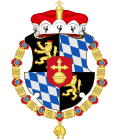 | |||||||||||||||||||
.svg.png) Electoral Palatinate within the Holy Roman Empire, 1618 | |||||||||||||||||||
_-_Numbered.svg.png) Map of the different Oberämter of the Electoral Palatinate in 1789 | |||||||||||||||||||
| Status | State of the Holy Roman Empire Imperial elector | ||||||||||||||||||
| Capital | Heidelberg (1085–1690) Düsseldorf (1690–1720) Mannheim (1720–1803) | ||||||||||||||||||
| Common languages | German | ||||||||||||||||||
| Religion | Dominant confession among the population was Roman Catholic (1085–1556), Lutheran (1556–1563) and Calvinist (1563–1803). Elector was Roman Catholic until the 1530s, then Lutheran until 1559, then Calvinist until 1575, then again Lutheran until 1583, then again Calvinist until 1685, and then again Roman Catholic since 1685. | ||||||||||||||||||
| Government | Feudal monarchy | ||||||||||||||||||
| Elector | |||||||||||||||||||
• 1085–1095 | Henry of Laach (first) | ||||||||||||||||||
• 1799–1803 | Maximilian II (last) | ||||||||||||||||||
| Historical era | Middle Ages | ||||||||||||||||||
| 1085 | |||||||||||||||||||
| 10 January 1356 | |||||||||||||||||||
| 15 May – 24 October 1648 | |||||||||||||||||||
| 30 December 1777 | |||||||||||||||||||
| 9 February 1801 | |||||||||||||||||||
| 27 April 1803 | |||||||||||||||||||
| |||||||||||||||||||
| Today part of | |||||||||||||||||||
The fragmented territory stretched from the left bank of the Upper Rhine, from the Hunsrück mountain range in what is today the Palatinate region in the German federal state of Rhineland-Palatinate and the adjacent parts of the French regions of Alsace and Lorraine (bailiwick of Seltz from 1418 to 1766) to the opposite territory on the east bank of the Rhine in present-day Hesse and Baden-Württemberg up to the Odenwald range and the southern Kraichgau region, containing the capital cities of Heidelberg and Mannheim.
The Counts Palatine of the Rhine held the office of imperial vicars in the territories under Frankish law (in Franconia, Swabia and the Rhineland) and ranked among the most significant secular Princes of the Holy Roman Empire. In 1541 elector Otto Henry converted to Lutheranism. Their climax and decline is marked by the rule of Elector Palatine Frederick V, whose coronation as King of Bohemia in 1619 sparked the Thirty Years' War. After the 1648 Peace of Westphalia, the ravaged lands were further afflicted by the "Reunion" campaigns launched by King Louis XIV of France, culminating in the Nine Years' War (1688–97). Ruled in personal union with the Electorate of Bavaria from 1777, the Electoral Palatinate was finally disestablished with the German mediatization in 1803.
History
The comital office of Count Palatine at the Frankish court of King Childebert I was already mentioned about 535. The Counts Palatine were the permanent representatives of the King, in particular geographic areas, in contrast to the semi-independent authority of the dukes (and their successors). Under the Merovingian dynasty, the position had been a purely appointed one, but by the Middle Ages had evolved into an hereditary one.
Up to the 10th century, the Frankish empire was centered at the royal palace (Pfalz) in Aachen, in what had become the Carolingian kingdom of Lotharingia. Consequently, the Count Palatine of Lotharingia became the most important of the Counts Palatine. Marital alliances meant that, by the Middle Ages, most Count Palatine positions had been inherited by the duke of the associated province, but the importance of the Count Palatine of Lotharingia enabled it to remain an independent position.
County Palatine of Lotharingia
In 985, Herman I, a scion of the Ezzonids, is mentioned as count palatine of Lotharingia (which by then had been divided into Upper and Lower Lorraine). While his Palatine authority operated over the whole of Upper Lorraine, the feudal territories of his family were instead scattered around south western Franconia, including parts of the Rhineland around Cologne and Bonn, and areas around the Moselle, and the Nahe Rivers.
In continual conflicts with the rivalling Archbishops of Cologne, he changed the emphasis of his rule to the southern Eifel region and further to the Upper Rhine, where the Ezzonian dynasty governed several counties on both banks of the river. The southernmost point was near Alzey.[6]
Counts Palatine of the Rhine
From about 1085/86, after the death of the last Ezzonian count palatine Herman II, Palatinate authority ceased to have any military significance in Lotharingia. In practice, the Count Palatinate's Palatine authority had collapsed, reducing his successor (Henry of Laach) to a mere feudal magnate over his own territories - along the Upper Rhine in south-western Franconia. From this time on, his territory became known as the County Palatine of the Rhine (not because Palatine authority existed there, but as an acknowledgement that the Count still held the title, if not the authority, of Count Palatine).
Various noble dynasties competed to be enfeoffed with the Palatinate by the Holy Roman Emperor - among them the House of Ascania, the House of Salm (Count Otto I of Salm in 1040) and the House of Babenberg (Henry Jasomirgott in 1140/41).
The first hereditary Count Palatine of the Rhine was Conrad, a member of the House of Hohenstaufen and younger half-brother of Emperor Frederick Barbarossa. The territories attached to this hereditary office in 1156 started from those held by the Hohenstaufens in the Donnersberg, Nahegau, Haardt, Bergstraße and Kraichgau regions (other branches of the Hohenstaufens received lands in the Duchy of Swabia, Franche-Comté, and so forth). Much of this was from their imperial ancestors, the Salian emperors, and apart from Conrad's maternal ancestry, the Counts of Saarbrücken. These backgrounds explain the composition of Upper and Rhenish Palatinate in the inheritance centuries onwards. About 1182, Conrad moved his residence from Stahleck Castle near Bacharach up the Rhine River to Heidelberg.
.svg.png)
Upon Conrad's death in 1195, the Palatinate passed to the House of Welf through the—secret—marriage of his daughter Agnes with Henry of Brunswick. When Henry's son Henry the Younger died without heirs in 1214, the Hohenstaufen king Frederick II enfeoffed the Wittelsbach duke Louis I of Bavaria. The Bavarian House of Wittelsbach eventually held the Palatinate territories until 1918.
During a later division of territory among the heirs of Duke Louis II, Duke of Upper Bavaria, in 1294, the elder branch of the Wittelsbachs came into possession of both the Rhenish Palatinate and the territories in the Bavarian Nordgau (Bavaria north of the Danube river) with the centre around the town of Amberg. As this region was politically connected to the Rhenish Palatinate, the name Upper Palatinate (German: Oberpfalz) became common from the early 16th century in contrast to the Lower Palatinate along the Rhine.
With the Treaty of Pavia in 1329, the Wittelsbach emperor Louis IV, a son of Louis II, returned the Palatinate to his nephews Rudolf and Rupert.
-DE.svg.png)
Electorate
In the Golden Bull of 1356, the Palatinate was recognized as one of the secular electorates, and given the hereditary offices of archsteward (German: Erztruchseß, Latin: Archidapifer) of the Empire and imperial vicar (Reichsverweser) of Franconia, Swabia, the Rhine, and southern Germany. From that time forth, the Count Palatine of the Rhine was usually known as the Elector Palatine (German: Kurfürst von der Pfalz, Latin: Palatinus elector).
Due to the practice of dividing territories among different branches of the family, by the early 16th century junior lines of the Palatine Wittelsbachs came to rule in Simmern, Kaiserslautern, and Zweibrücken in the Lower Palatinate, and in Neuburg and Sulzbach in the Upper Palatinate. The Elector Palatine, now based in Heidelberg, adopted Lutheranism in the 1530s; when the senior branch of the family died out in 1559, the Electorate passed to Frederick III of Simmern, a staunch Calvinist, and the Palatinate became one of the major centers of Calvinism in Europe, supporting Calvinist rebellions in both the Netherlands and France.
Thirty Years' War

In 1619, the Protestant Frederick V, Elector Palatine accepted the throne of Bohemia from the Bohemian estates. This initiated the 1618-1648 Thirty Years' War, one of the most destructive conflicts in human history; it caused over eight million fatalities from military action, violence, famine and plague, the vast majority in the German states of the Holy Roman Empire.[7] In terms of proportional German casualties and destruction, it was surpassed only by the period January to May 1945 and remains the single greatest war trauma in German memory.[8]
Frederick was evicted from Bohemia in 1620 following his defeat by the forces of Emperor Ferdinand II at the Battle of the White Mountain. Over the period 1621-1622, the Palatinate was occupied by Spanish and Bavarian troops and Frederick was exiled to the Dutch Republic. His territories and electoral rights were transferred to the distantly related but Catholic Maximilian I of Bavaria, who now became Elector of Bavaria.
After his death in 1632, Frederick's daughter Princess Elizabeth and wife Elizabeth Stuart, Queen of Bohemia, worked tirelessly to have the Palatinate restored to her son Charles Louis and the Protestant cause. When the Peace of Westphalia ended the war in 1648, he regained the Lower Palatinate and the title 'Elector Palatine' but now ranked lower in precedence than the others. He was succeeded by Charles II, Elector Palatine in 1680 but the Simmern family became extinct in the male line after he died in 1685.
Later history
In 1670, Charles II's cousin Elizabeth Charlotte of the Palatinate married Philippe of Orléans, younger brother of Louis XIV; on this basis, Louis claimed half of the Palatinate for France. The direct heir to the Palatinate was Philip William, Catholic Count Palatine of Neuburg, Duke of Jülich and Berg. His eldest daughter Eleonore married Emperor Leopold, while another, Maria Anna, married Charles II of Spain in 1690.
When France invaded the Palatinate in September 1688 to enforce their claim, these wider connections meant the conflict rapidly escalated and contributed to the outbreak of the 1689–1697 Nine Years War. The French were forced to withdraw in 1689 but before doing so, they destroyed much of Heidelberg, another 20 substantial towns and numerous villages.[9] This destruction was systematically applied across a large section of the Rhineland but especially the Palatinate, which was raided again in 1693; the devastation shocked much of Europe.[10] France later renounced its claim in the 1697 Treaty of Ryswick.
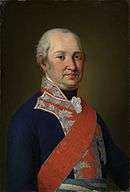
Johann Wilhelm succeeded as Elector in 1690, changing his residence first to Düsseldorf, then back to Heidelberg and finally Mannheim in 1720. Like his father, he was a Catholic, which under the 1555 Peace of Augsburg meant the Protestant majority in the Palatine should convert to Catholicism. The 1705 'Palatine Church Division' compromised by allocating 5/7ths of public church property to the Reformed or Calvinist church and 2/7ths to the Catholic, but excluded the Lutheran Church, whose membership exceeded 40% of the population in some areas.[11]
In 1716, Charles Philip succeeded his brother as Elector and in January 1742, helped his cousin Charles Albert become the first non-Habsburg Emperor in over 300 years.[12] He died in December and the Palatinate passed to Charles Theodore, then Duke of Sulzbach, who also inherited the Electorate of Bavaria in 1777. The title and authority of the two Electorates were combined, Charles and his heirs retaining only the vote and precedence of the Bavarian elector, although continuing to use the title 'Count Palatine of the Rhine' (German: Pfalzgraf bei Rhein, Latin: Comes Palatinus Rheni).
The Palatine territories on the left bank of the Rhine were annexed by France in 1795, mainly becoming part of the Mont-Tonnerre department; those on the right were taken by the Elector of Baden, after the 1805 Peace of Pressburg dissolved the Holy Roman Empire; the remaining Wittelsbach territories were united by Maximilian Joseph as the Kingdom of Bavaria.[13]
 Heidelberg Castle 1670
Heidelberg Castle 1670- Facade of Heidelberg Castle, destroyed by the French in 1689 and never rebuilt
 Schwetzingen Castle
Schwetzingen Castle The Palatinate territories, ca 1780
The Palatinate territories, ca 1780
After the Empire

In 1806, Baden was raised to a grand duchy and parts of the former Palatinate including Mannheim became part of it. At the Congress of Vienna in 1814 and 1815, southern parts of the left-bank Palatinate were restored and enlarged by mediatisation (consuming the former Bishopric of Speyer, the Free Imperial City of Speyer, and others) up to the new border with France, and given (temporarily) to the Habsburg Austrian Empire; after this time, it was this new region that was principally known as "the Palatinate". The right-bank Palatinate remained with Baden while northern parts became part of Prussia (Rhine Province) and Hesse (Rhenish Hesse).
In 1816, the Palatinate became a formal part of the Wittelsbach Kingdom of Bavaria (the Rheinkreis or Circle of the Rhine) in a pre-arranged exchange for Tirol, which Bavaria ceded to Austria. Most of the area remained a part of Bavaria until after the Second World War (after 1918 the Free State of Bavaria), with some western parts becoming part of the Territory of the Saar Basin after World War I.
In September 1946 the territory was made part of the new state of Rhineland-Palatinate, along with former left bank territories of Prussia (southern part of the Rhine Province, including the former Principality of Birkenfeld which had been an exclave of Oldenburg until 1937, and western parts of the Province of Nassau) and Rhenish Hesse. The former Territory of the Saar Basin was reinstated and expanded to create the French Saar Protectorate, which returned to Germany in 1956 as the modern state of Saarland.
Coat of arms
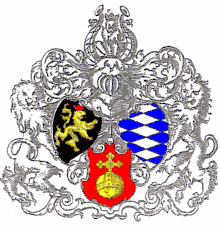
In 1156 Conrad of Hohenstaufen, brother of emperor Frederick Barbarossa became Count Palatine. The old coat of arms of the House of Hohenstaufen, the single lion, became coat of arms of the palatinate.
By marriage, the Palatinate's arms also became quartered with those of Welf and later Wittelsbach.[15] The arms of Bavaria were used with reference to the elector's holdings in Bavaria. This was extended to quartering of the lion and the Bavarian Arms upon the ascension of Maximilian I to the position of elector of the Palatinate in 1623, used concurrently with the arms shown. The orb represented their position as Arch-Steward of the Holy Roman Empire.
.svg.png) Under the rule of the Hohenstaufen and the Welfs
Under the rule of the Hohenstaufen and the Welfs.svg.png) Under the rule of the Wittelsbachs
Under the rule of the Wittelsbachs.svg.png) Under the House of Palatinate-Simmern
Under the House of Palatinate-Simmern Greater Coat of arms under the House of Palatinate-Simmern, 1548 (Coa of Frederick II)
Greater Coat of arms under the House of Palatinate-Simmern, 1548 (Coa of Frederick II).svg.png) Coat of arms of the Counts Palatines of Simmern
Coat of arms of the Counts Palatines of Simmern
See also
- List of rulers of the Electoral Palatinate
- Palatinate-Neuburg
- Palatinate-Sulzbach
- Palatine Zweibrücken
- Palatine Lion
- List of coats of arms with the Palatine Lion
References
- Based on many original preserved depictions:
- Hirschberg-Journal.de
- Based on many original preserved depictions:
- Hirschberg-Journal.de
- Palatine & Palatinate by Ralph Dornfeld Owen, p. 231. Retrieved 29 Nov 2015.
- Kohnle, Armin (2005). "Mittelalterliche Grundlagen; Pfalzgraftenamt, Territorialentwicklung und Kurwürde". Kleine Geschichte der Kurpfalz [A short history of the Electoral Palatinate]. Regionalgeschichte-fundiert und kompakt (in German) (First ed.). Karlsruhe: G. Braun Buchverlag. p. 17. ISBN 978-3-7650-8329-7.
- Wilson, Peter (2009). Europe's Tragedy: A New History of the Thirty Years War (2010 ed.). Penguin. p. 787. ISBN 978-0-14-100614-7.
- "Der Dreißigjährige Krieg - die Urkatastrophe der deutschen Geschichte?". Der Teckbote (in German). 2014-10-21. Retrieved 2018-07-23.
- Lynn, John (1999). The Wars of Louis XIV, 1667-1714 (Modern Wars In Perspective). Longman. p. 198. ISBN 978-0582056299.
- Dosquet, Emilie (2016). "The Desolation of the Palatinate as a European News Event". The Desolation of the Palatinate as a European News Event in News Networks in Early Modern Europe. News Networks in Early Modern Europe. Brill. pp. 643–644. ISBN 978-9004277175. JSTOR 10.1163/j.ctt1w8h1ng.35.
- Beiler, Rosalind (2008). Immigrant and Entrepreneur: The Atlantic World of Caspar Wistar, 1650-1750. The Pennsylvania State University Press. pp. 60–61. ISBN 978-0271035956. Retrieved 28 October 2018.
- Lindsay, JO (1957). The New Cambridge Modern History: Volume 7, The Old Regime, 1713-1763. Cambridge University Press; New edition. p. 420. ISBN 978-0521045452.
- Nicholls, David (1999). Napoleon: A Biographical Companion. ABC-CLIO; Annotated edition. p. 18. ISBN 978-0874369571.
- Siebmacher, Johann (1703). Erneuertes und vermehrtes Wappenbuch... Nürnberg: Adolph Johann Helmers. pp. Part I Table 2.
- Diemer, Klaus (2007). "Der Pfälzer Löwe" [The Palatinate Lion]. Archived from the original on 2008-05-02.
External links
| Wikimedia Commons has media related to Palatinate. |
- (in German) Heidelberg and the Palatine; elaborate information on history and architecture, illustrated with many pictures.
- (in German) Virtual Library of the History of the Electoral Palatinate
- Charles D. Gunnoe, (2004) "Palatinate" in Europe, 1450 to 1789: Encyclopedia of the Early Modern World

